Hognose Snake Morphs: Discover The 25+ Types Of Hognose Snake Breeds
#mobileSnakeQuizControls { overflow: hidden; text-overflow: ellipsis; white-space: nowrap; }
@media (min-width: 481px) {
.mobile-top-content {
display: none;
}
}
#mobileTopContentCTACarouselControls { overflow: hidden; text-overflow: ellipsis; white-space: nowrap; }
.mobile-top-content .more { color: #fff; }
.mobile-top-content a { color: #fff; text-decoration: underline; }
.mobile-top-content a:hover { color: #fff; text-decoration: underline; }
@media (max-width: 480px) {
.mobile-top-content {
background-color: #06a10b;
color: #fff;
text-align: center;
/*height: 60px;
padding-top:5px;*/
font-size:80%;
/* display: block; */
margin: 0px -30px;
}
}
Hognose snakes have become some of the most popular pet snakes in the United States, and there is good reason! Although there are a few species of hognose, the easiest to care for and most common type is Heterodon nasicus, otherwise known as the western hognose snake. The western hognose comes in some truly incredible color variations, making it a great option for reptile enthusiasts. Let’s explore some of the coolest hognose snake morphs in the world!
What Is A Hognose Snake Morph?
A “morph” is a particular pattern or color trait that shows itself in a snake. Once breeders have identified certain genetic lines that carry these “morphs,” they can carefully select for them. Certain morphs can be reliably bred and sold to consumers a few generations later.
For people who love unique and interesting snakes, morphs are almost an expression art, only instead of paint as the medium, its genetic selection! Today, we will go over some of the coolest hognose snake morphs. Additionally, we will list some of the less common ones for anyone wanting to do a “deep dive” into the world of hognose snake morphs.
button.pulse {
transform: scale(1); animation: pulse 2s infinite;
box-shadow: 0 0 0 0 rgba(11, 247, 25, 1);
}
@keyframes pulse {
0% { transform: scale(0.90); box-shadow: 0 0 0 0 rgba(11, 247, 25, 0.5); }
60% { transform: scale(1); box-shadow: 0 0 0 15px rgba(11, 247, 25, 0); }
100% { transform: scale(0.90); box-shadow: 0 0 0 0 rgba(11, 247, 25, 0); }
}
The 15 Coolest Hognose Snake Morphs (plus all the others)
| Morph | Price |
|---|---|
| Albino | $350 |
| Anaconda | $250 |
| Arctic | $350+ |
| Axanthic | $450 |
| Caramel | $350 |
| Extreme Red | $400 |
| Granite | Unknown |
| Hypo | $350 |
| Jaguar | $350+ |
| Lavender | $600+ |
| Leucistic | $6,000 |
| Mocha | Unknown |
| Sable | $900+ |
| Shadow | $500+ |
| Tiger | $400+ |
| Toffee | $300+ |
Base Morph (normal or wildtype)
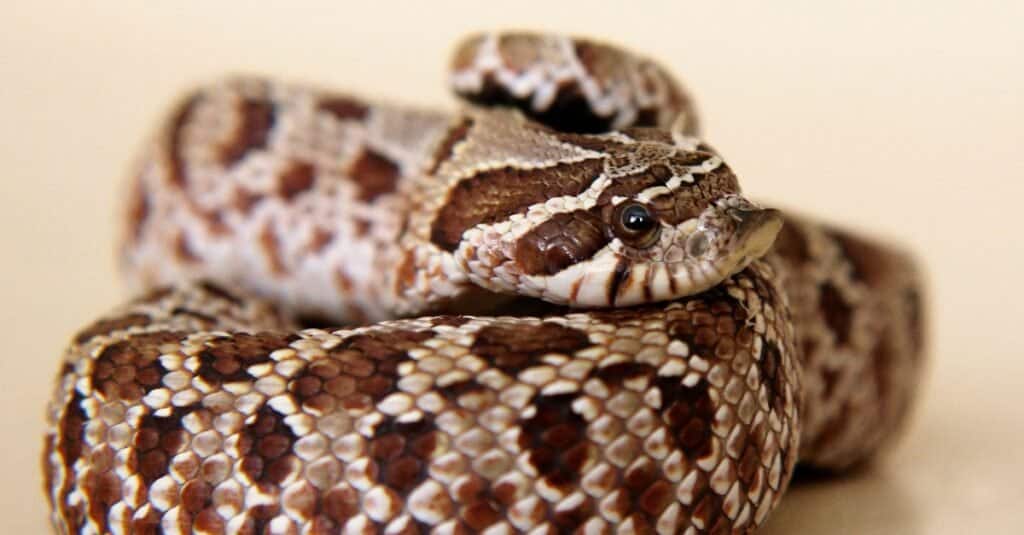
iStock.com/Iuliia Morozova
The “base” morph or standard hognose snake coloring is known as its wildtype. This is the way you would usually find the snake in the wild, living its life free of human intervention. The wildtype hognose snake is a light tan with dark brown spots repeating from head to tail. Anything majorly different from this standard coloration or pattern is identified as a morph.
Albino Morph
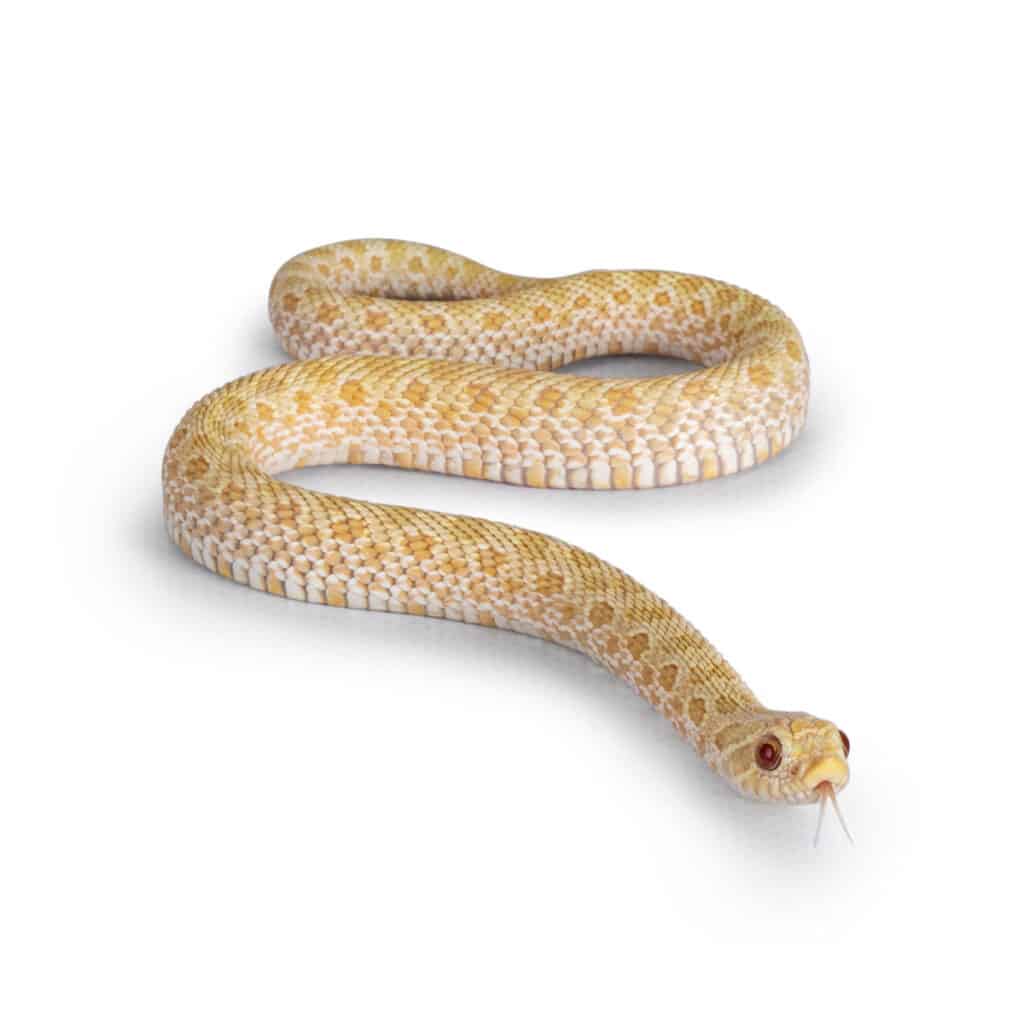
Nynke van Holten/Shutterstock.com
The albino hognose snake morph is characterized by its lack of melanin. This reduction in melanin (dark pigmentation) creates a snake with a white body and orange, yellow, or red spots across the back of the snake. Albino animals are quite famous in the animal world, and these rare morphs are especially valued.
Many albino morphs are combined with other traits to create even more unique colorations and patterns. Many of the following morphs are a subset or cross of the base albino trait.
Anaconda Morph
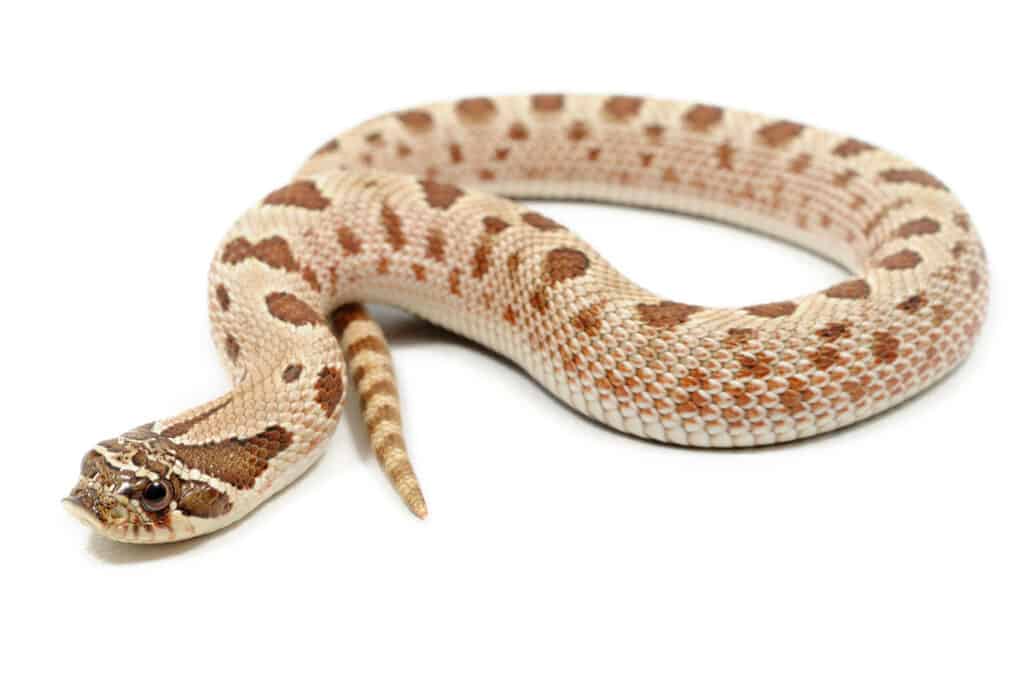
iStock.com/Florian DENIS
The anaconda hognose snake morph is characterized by its spaced-out spot pattern, dark belly with white walls, and a distinct resemblance to an anaconda’s patterning. This morph results from an incomplete dominant trait, but when bred with another anaconda, the resulting snake is known as a “super” anaconda.
Super anacondas have light bodies, a few brown markings on their heads, and a patternless body.
Arctic Morph
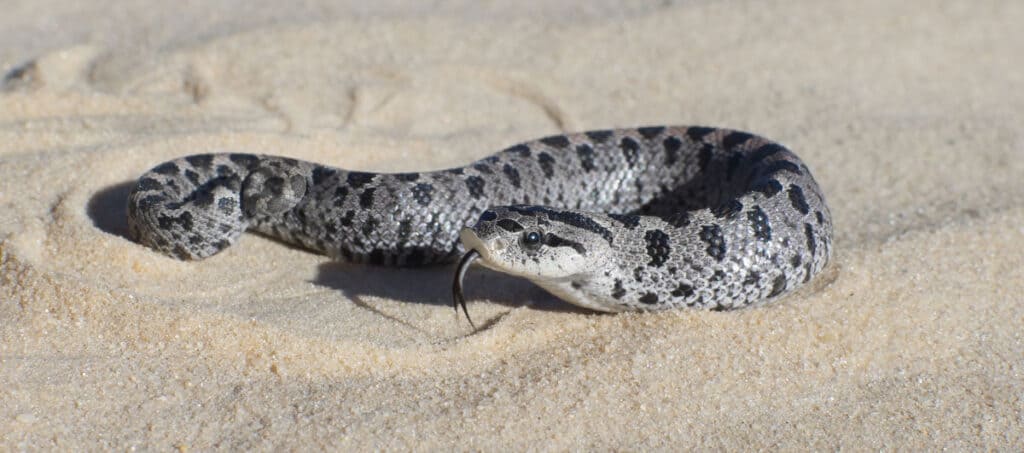
Chase D’animulls/Shutterstock.com
The arctic hognose snake morph is characterized by its high contrast coloring with darker spots and a lighter body. The snake’s body often appears white or tan, while the spots are light brown. A “super” arctic morph is created when two arctic snakes are bred together.
Super arctic morphs are extremely high contrast with almost white bodies and dark brown or black spots across their bodies.
Axanthic Morph

fivespots/Shutterstock.com
The axanthic morph is a trait that reduces red pigmentation in a snake. The resulting snake usually expresses cleaner black and white colorations, occasionally bordering on grey.
Caramel Morph

fivespots/Shutterstock.com
The caramel hognose snake morph is characterized by a lack of melanin but not total removal of it. The resulting snake is usually light yellow or tan with caramel markings across its body.
Extreme Red Morph
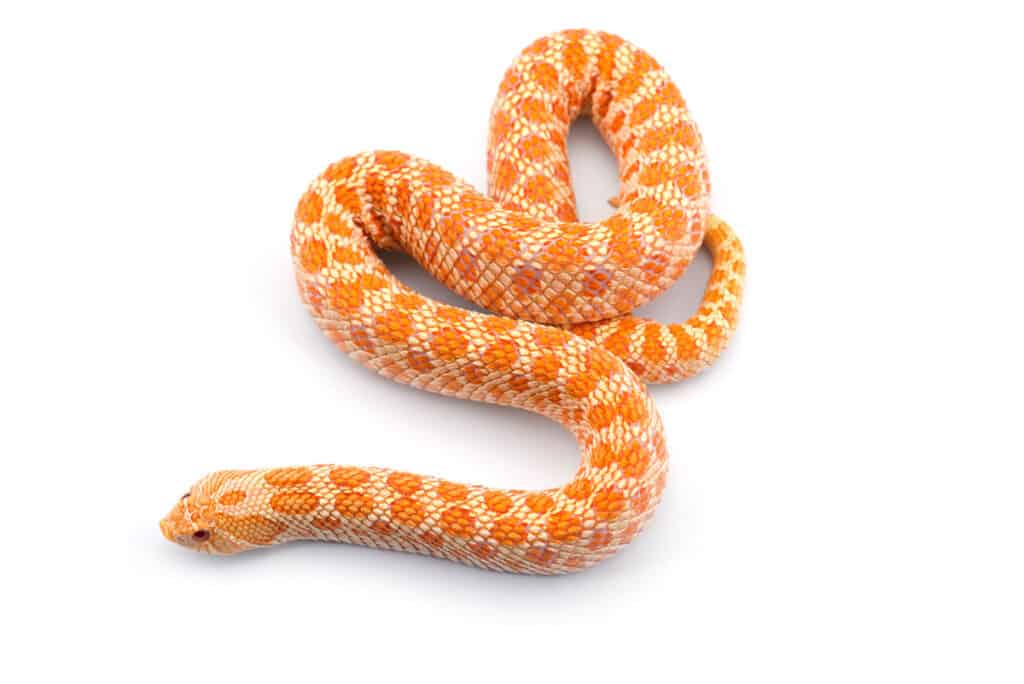
PetlinDmitry/Shutterstock.com
The extreme red hognose snake morph is characterized by extreme red pigmentation across the body. The resulting snake can take on a variety of colors, but when present in an albino morph, the snake has a white body with clear, contrasting red spots. It is easily one of the most beautiful morphs on the list!
Granite Morph
The granite hognose snake morph is characterized by its strange patterning and irregular coloring. The resulting snake can often resemble the patterning of granite rocks. Granite morphs usually have smaller and more spaced-out spots with darker melanin concentrations found in the spots.
Hypo Morph
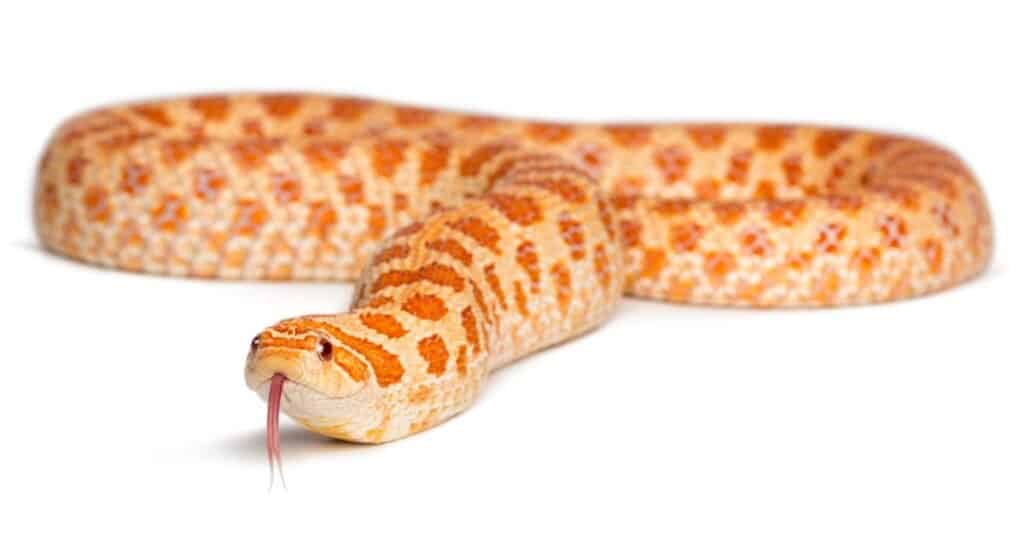
iStock.com/GlobalP
A hypo snake morph is short for hypomelanistic and is used to describe many snake species that have reduced melanin in their scales. In hognose snake morphs, hypo snakes can come in three main groups: true hypos, Dutch hypos, and green hypos.
True hypos have grey colorations where they would normally express brown and often rake on a red or yellow pigment everywhere else. Dutch hypos aren’t technically hypomelanistic but are actually a variation of albinism that displays certain dark pigments. Green hypos have reduced melanin and a smoky hue across their backs and bellies. As they age, they often take on a green hue across certain parts of their body.
Jaguar Morph
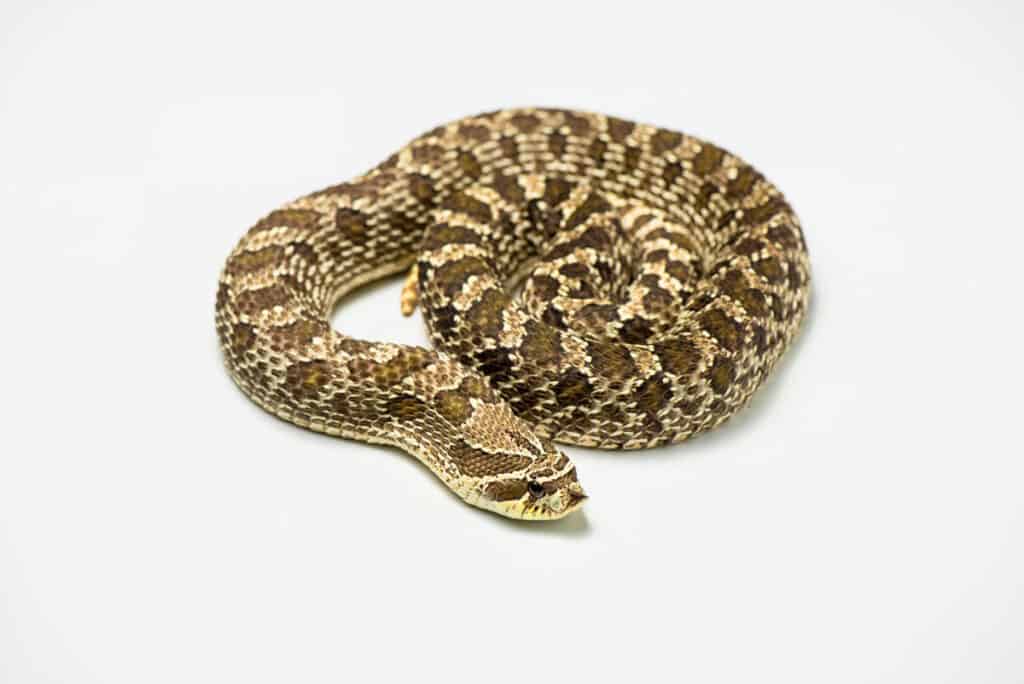
Peterpancake/Shutterstock.com
The jaguar hognose snake morph is characterized by its aberrant patterns that resemble that of a jaguar. These morphs often have a distinctly darker edge to their spots. The result is a unique spot pattern, and it is highlighted more than other morphs.
Lavender Morph
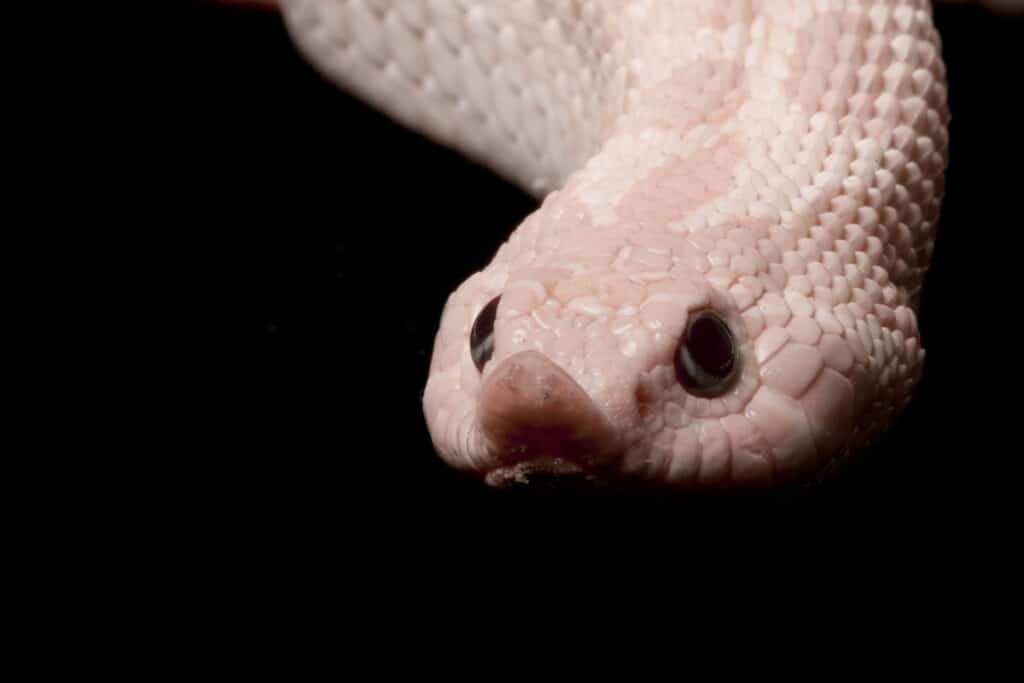
fivespots/Shutterstock.com
The lavender hognose snake morph is characterized by its lack of melanin, producing a lavender or pink snake with dark eyes. These snakes are very rare in the hognose snake breeding scene, so expect to pay a premium for them! Still, they are some of the most beautiful snakes around.
Leucistic Morph
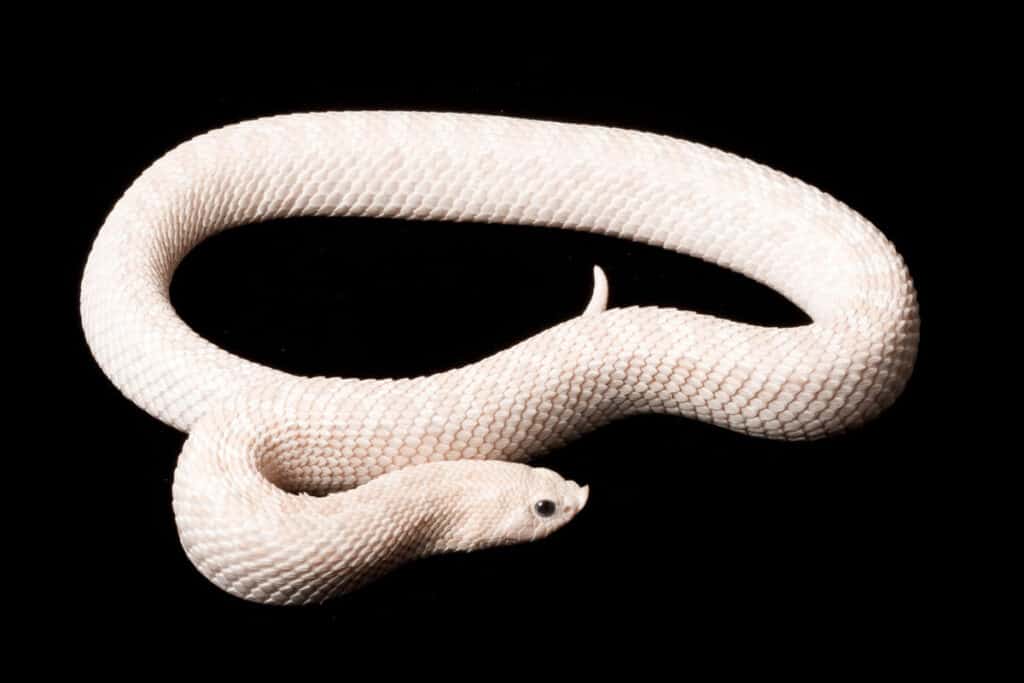
fivespots/Shutterstock.com
A leucistic morph is a snake morph that usually results in a snake with a stark white body and dark black or blue eyes. The same holds true for leucistic hognose snakes, but the rarity of these snakes makes them quite expensive.
Mocha Morph
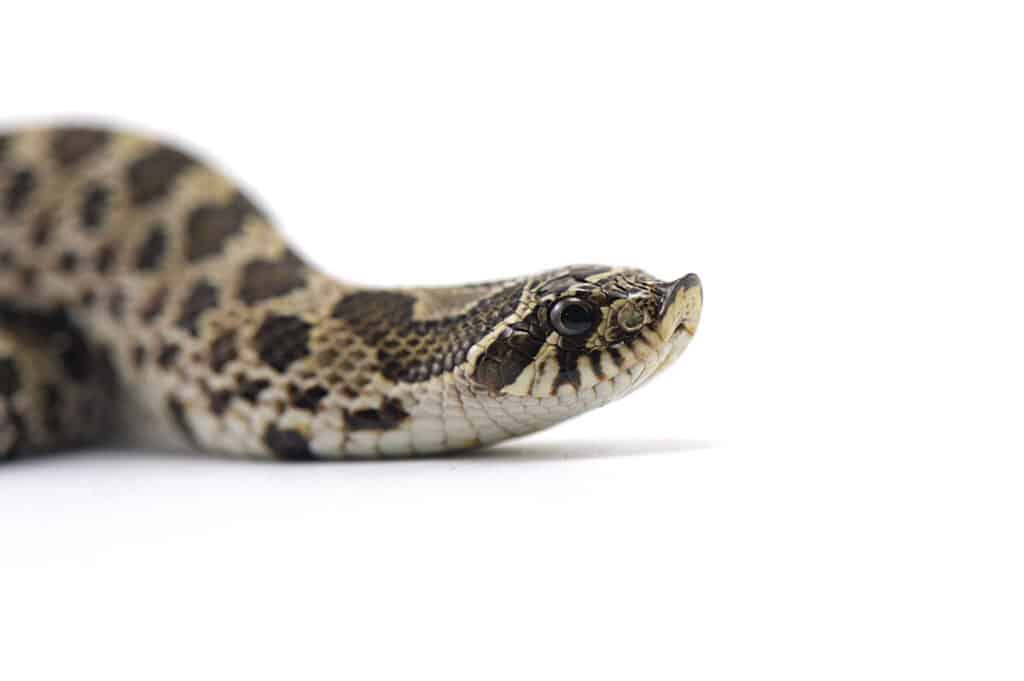
PetlinDmitry/Shutterstock.com
The mocha hognose snake morph is uncommon, and little to no breeding records exist about it. The snake is reported to have larger, dark brown spots with a white or cream base between them. Smaller dark spots also exist along the sides of the snake. Since the snake is such a rich brown color, the “mocha” name seems fitting!
Sable Morph
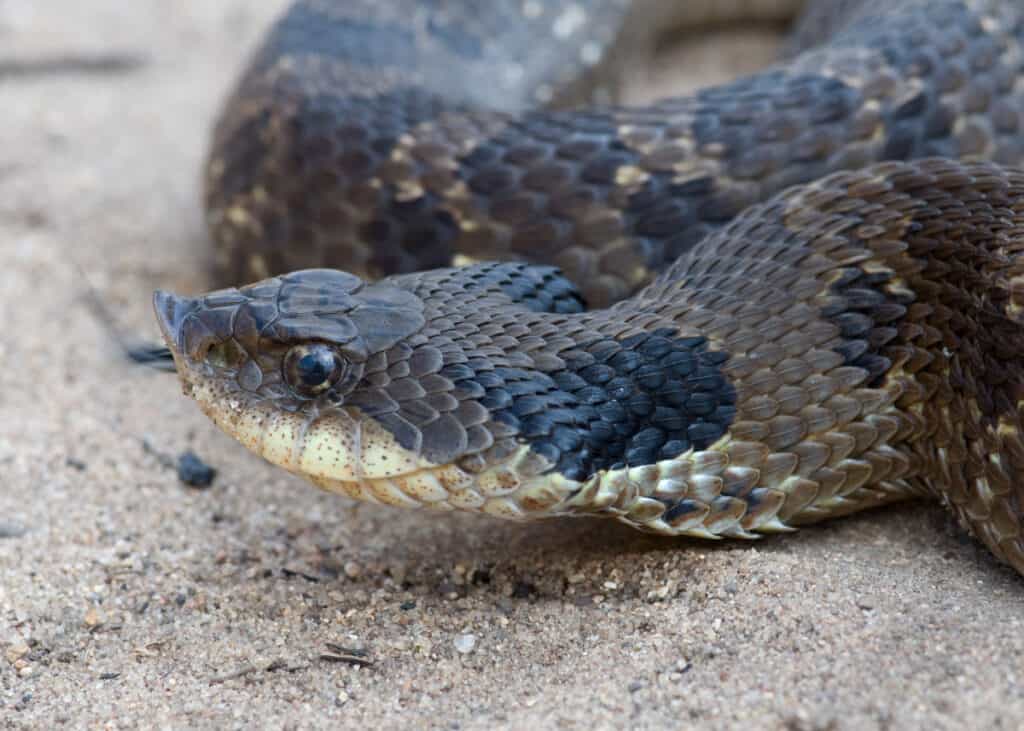
Gerald A. DeBoer/Shutterstock.com
The sable hognose snake morph is characterized by an overall increase in pigmentation across the snake. The resulting snake is darker but with a unique set of nearly transparent or translucent scales around the belly and chin.
Shadow Morph
The shadow hognose snake morph is characterized by large squarish spots across its back with a higher pigmentation concentration. The body is usually cream, and the snake often has a “blush” line (fading area) that creates the impression of a shadow.
Tiger Morph
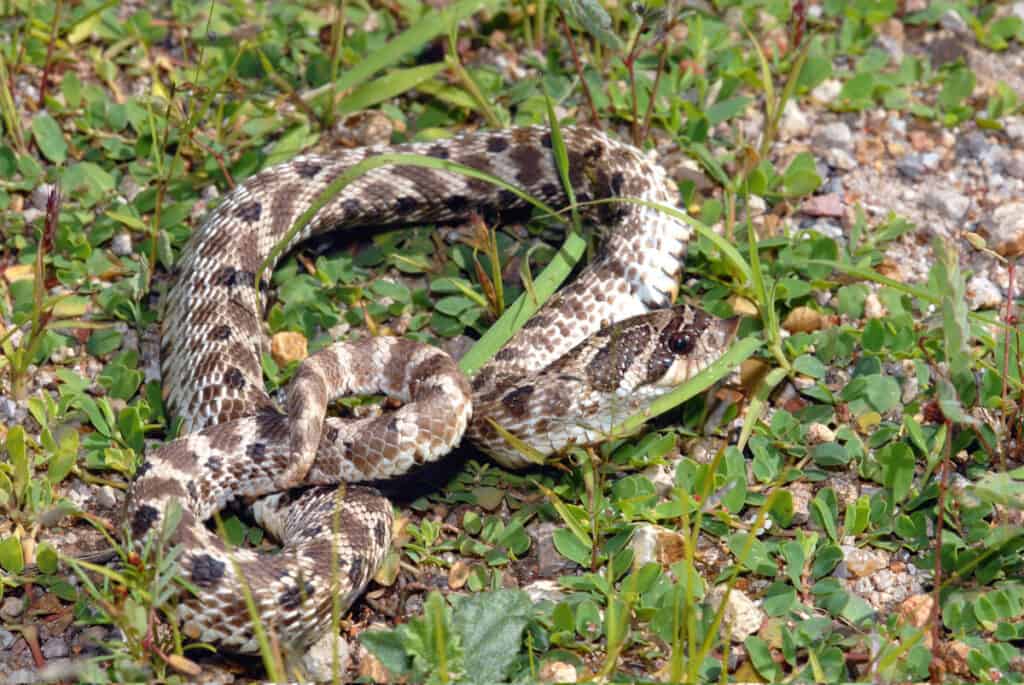
Rusty Dodson/Shutterstock.com
The tiger morph is a pattern trait that results in the characteristic spots becoming stripes. This trait can be combined with others to create different colors to compliment the “tiger” aesthetic.
Toffee Morph
The toffee morph is characterized by a lack of melanin but with distinct black speckling on the underside of the belly. As the snake ages, these spots usually develop further and can create a purplish belly on the snake.
Other Possible Morphs
- Lemon ghost
- Pink pastel
- Pistachio
- Purple line
- RBE Pastel
- Swiss chocolate
- Twinspot
- Lemon hypo
- Green phase
- Reverse stripe
Discover the “Monster” Snake 5X Bigger than an Anaconda
Every day A-Z Animals sends out some of the most incredible facts in the world from our free newsletter. Want to discover the 10 most beautiful snakes in the world, a “snake island” where you’re never more than 3 feet from danger, or a “monster” snake 5X larger than an anaconda? Then sign up right now and you’ll start receiving our daily newsletter absolutely free.
More from A-Z Animals
.more-snake-card-image { max-height:140px !important; }
#mobileSnakeQuizControls { overflow: hidden; text-overflow: ellipsis; white-space: nowrap; }
@media (min-width: 481px) {
.mobile-top-content {
display: none;
}
}
#mobileTopContentCTACarouselControls { overflow: hidden; text-overflow: ellipsis; white-space: nowrap; }
.mobile-top-content .more { color: #fff; }
.mobile-top-content a { color: #fff; text-decoration: underline; }
.mobile-top-content a:hover { color: #fff; text-decoration: underline; }
@media (max-width: 480px) {
.mobile-top-content {
background-color: #06a10b;
color: #fff;
text-align: center;
/*height: 60px;
padding-top:5px;*/
font-size:80%;
/* display: block; */
margin: 0px -30px;
}
}
Hognose snakes have become some of the most popular pet snakes in the United States, and there is good reason! Although there are a few species of hognose, the easiest to care for and most common type is Heterodon nasicus, otherwise known as the western hognose snake. The western hognose comes in some truly incredible color variations, making it a great option for reptile enthusiasts. Let’s explore some of the coolest hognose snake morphs in the world!
What Is A Hognose Snake Morph?
A “morph” is a particular pattern or color trait that shows itself in a snake. Once breeders have identified certain genetic lines that carry these “morphs,” they can carefully select for them. Certain morphs can be reliably bred and sold to consumers a few generations later.
For people who love unique and interesting snakes, morphs are almost an expression art, only instead of paint as the medium, its genetic selection! Today, we will go over some of the coolest hognose snake morphs. Additionally, we will list some of the less common ones for anyone wanting to do a “deep dive” into the world of hognose snake morphs.
button.pulse {
transform: scale(1); animation: pulse 2s infinite;
box-shadow: 0 0 0 0 rgba(11, 247, 25, 1);
}
@keyframes pulse {
0% { transform: scale(0.90); box-shadow: 0 0 0 0 rgba(11, 247, 25, 0.5); }
60% { transform: scale(1); box-shadow: 0 0 0 15px rgba(11, 247, 25, 0); }
100% { transform: scale(0.90); box-shadow: 0 0 0 0 rgba(11, 247, 25, 0); }
}
The 15 Coolest Hognose Snake Morphs (plus all the others)
| Morph | Price |
|---|---|
| Albino | $350 |
| Anaconda | $250 |
| Arctic | $350+ |
| Axanthic | $450 |
| Caramel | $350 |
| Extreme Red | $400 |
| Granite | Unknown |
| Hypo | $350 |
| Jaguar | $350+ |
| Lavender | $600+ |
| Leucistic | $6,000 |
| Mocha | Unknown |
| Sable | $900+ |
| Shadow | $500+ |
| Tiger | $400+ |
| Toffee | $300+ |
Base Morph (normal or wildtype)

iStock.com/Iuliia Morozova
The “base” morph or standard hognose snake coloring is known as its wildtype. This is the way you would usually find the snake in the wild, living its life free of human intervention. The wildtype hognose snake is a light tan with dark brown spots repeating from head to tail. Anything majorly different from this standard coloration or pattern is identified as a morph.
Albino Morph

Nynke van Holten/Shutterstock.com
The albino hognose snake morph is characterized by its lack of melanin. This reduction in melanin (dark pigmentation) creates a snake with a white body and orange, yellow, or red spots across the back of the snake. Albino animals are quite famous in the animal world, and these rare morphs are especially valued.
Many albino morphs are combined with other traits to create even more unique colorations and patterns. Many of the following morphs are a subset or cross of the base albino trait.
Anaconda Morph

iStock.com/Florian DENIS
The anaconda hognose snake morph is characterized by its spaced-out spot pattern, dark belly with white walls, and a distinct resemblance to an anaconda’s patterning. This morph results from an incomplete dominant trait, but when bred with another anaconda, the resulting snake is known as a “super” anaconda.
Super anacondas have light bodies, a few brown markings on their heads, and a patternless body.
Arctic Morph

Chase D’animulls/Shutterstock.com
The arctic hognose snake morph is characterized by its high contrast coloring with darker spots and a lighter body. The snake’s body often appears white or tan, while the spots are light brown. A “super” arctic morph is created when two arctic snakes are bred together.
Super arctic morphs are extremely high contrast with almost white bodies and dark brown or black spots across their bodies.
Axanthic Morph

fivespots/Shutterstock.com
The axanthic morph is a trait that reduces red pigmentation in a snake. The resulting snake usually expresses cleaner black and white colorations, occasionally bordering on grey.
Caramel Morph

fivespots/Shutterstock.com
The caramel hognose snake morph is characterized by a lack of melanin but not total removal of it. The resulting snake is usually light yellow or tan with caramel markings across its body.
Extreme Red Morph

PetlinDmitry/Shutterstock.com
The extreme red hognose snake morph is characterized by extreme red pigmentation across the body. The resulting snake can take on a variety of colors, but when present in an albino morph, the snake has a white body with clear, contrasting red spots. It is easily one of the most beautiful morphs on the list!
Granite Morph
The granite hognose snake morph is characterized by its strange patterning and irregular coloring. The resulting snake can often resemble the patterning of granite rocks. Granite morphs usually have smaller and more spaced-out spots with darker melanin concentrations found in the spots.
Hypo Morph

iStock.com/GlobalP
A hypo snake morph is short for hypomelanistic and is used to describe many snake species that have reduced melanin in their scales. In hognose snake morphs, hypo snakes can come in three main groups: true hypos, Dutch hypos, and green hypos.
True hypos have grey colorations where they would normally express brown and often rake on a red or yellow pigment everywhere else. Dutch hypos aren’t technically hypomelanistic but are actually a variation of albinism that displays certain dark pigments. Green hypos have reduced melanin and a smoky hue across their backs and bellies. As they age, they often take on a green hue across certain parts of their body.
Jaguar Morph

Peterpancake/Shutterstock.com
The jaguar hognose snake morph is characterized by its aberrant patterns that resemble that of a jaguar. These morphs often have a distinctly darker edge to their spots. The result is a unique spot pattern, and it is highlighted more than other morphs.
Lavender Morph

fivespots/Shutterstock.com
The lavender hognose snake morph is characterized by its lack of melanin, producing a lavender or pink snake with dark eyes. These snakes are very rare in the hognose snake breeding scene, so expect to pay a premium for them! Still, they are some of the most beautiful snakes around.
Leucistic Morph

fivespots/Shutterstock.com
A leucistic morph is a snake morph that usually results in a snake with a stark white body and dark black or blue eyes. The same holds true for leucistic hognose snakes, but the rarity of these snakes makes them quite expensive.
Mocha Morph

PetlinDmitry/Shutterstock.com
The mocha hognose snake morph is uncommon, and little to no breeding records exist about it. The snake is reported to have larger, dark brown spots with a white or cream base between them. Smaller dark spots also exist along the sides of the snake. Since the snake is such a rich brown color, the “mocha” name seems fitting!
Sable Morph

Gerald A. DeBoer/Shutterstock.com
The sable hognose snake morph is characterized by an overall increase in pigmentation across the snake. The resulting snake is darker but with a unique set of nearly transparent or translucent scales around the belly and chin.
Shadow Morph
The shadow hognose snake morph is characterized by large squarish spots across its back with a higher pigmentation concentration. The body is usually cream, and the snake often has a “blush” line (fading area) that creates the impression of a shadow.
Tiger Morph

Rusty Dodson/Shutterstock.com
The tiger morph is a pattern trait that results in the characteristic spots becoming stripes. This trait can be combined with others to create different colors to compliment the “tiger” aesthetic.
Toffee Morph
The toffee morph is characterized by a lack of melanin but with distinct black speckling on the underside of the belly. As the snake ages, these spots usually develop further and can create a purplish belly on the snake.
Other Possible Morphs
- Lemon ghost
- Pink pastel
- Pistachio
- Purple line
- RBE Pastel
- Swiss chocolate
- Twinspot
- Lemon hypo
- Green phase
- Reverse stripe
Discover the “Monster” Snake 5X Bigger than an Anaconda
Every day A-Z Animals sends out some of the most incredible facts in the world from our free newsletter. Want to discover the 10 most beautiful snakes in the world, a “snake island” where you’re never more than 3 feet from danger, or a “monster” snake 5X larger than an anaconda? Then sign up right now and you’ll start receiving our daily newsletter absolutely free.







